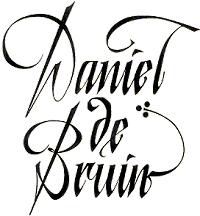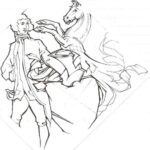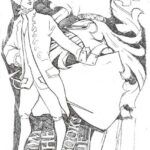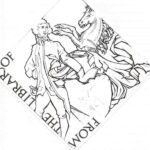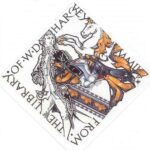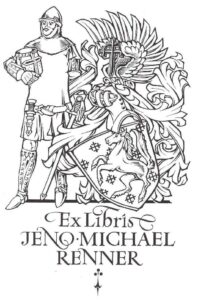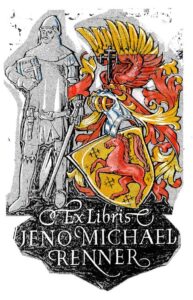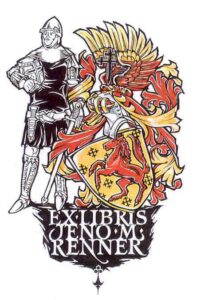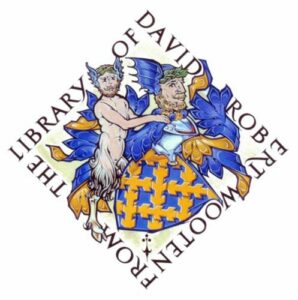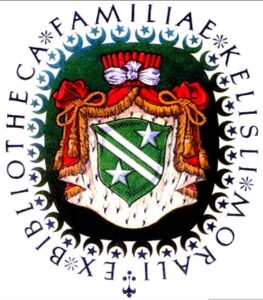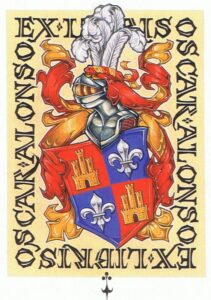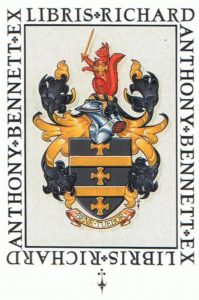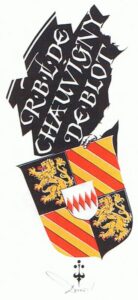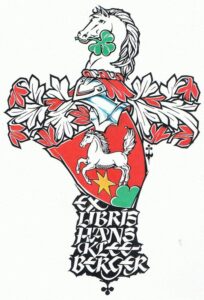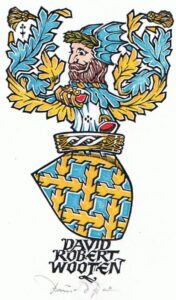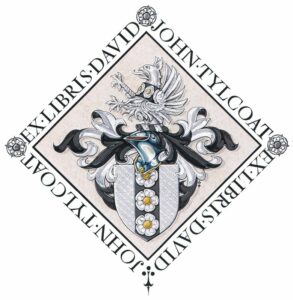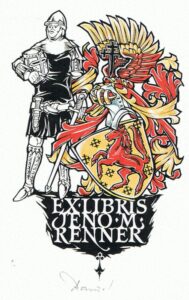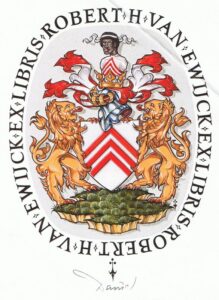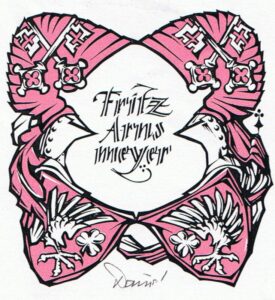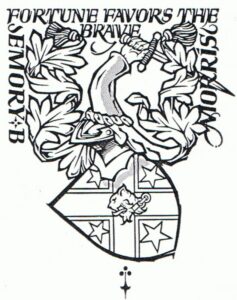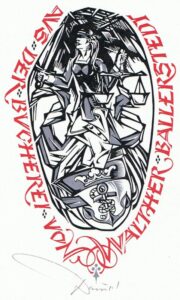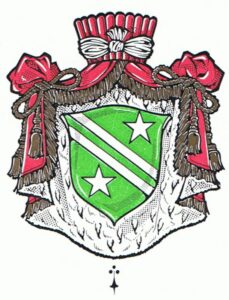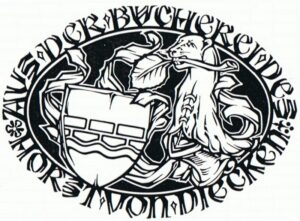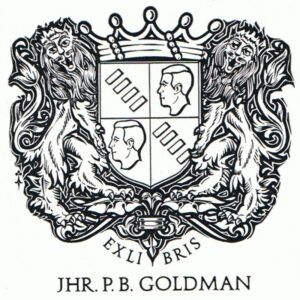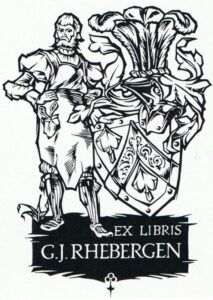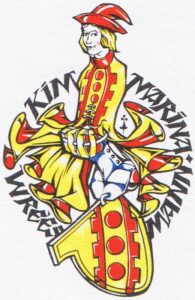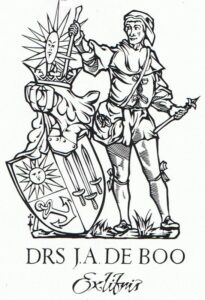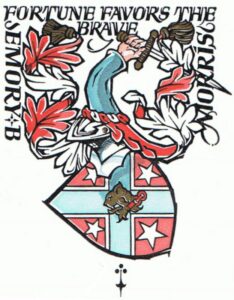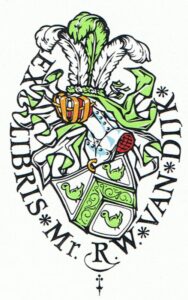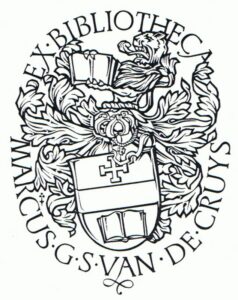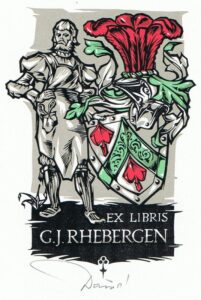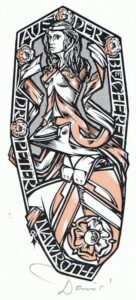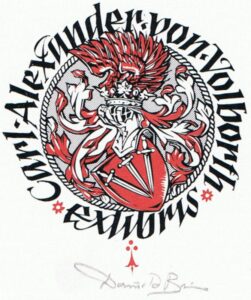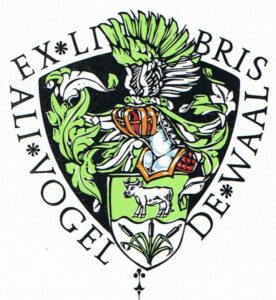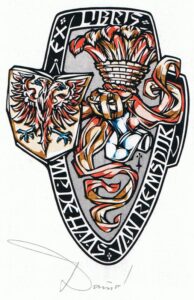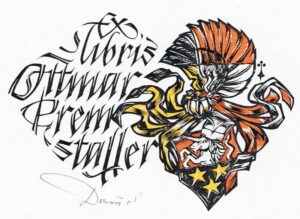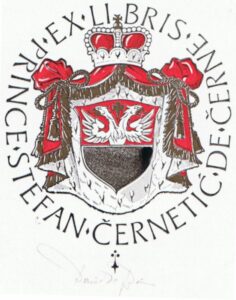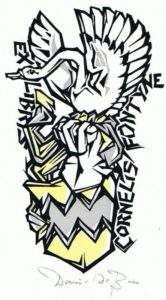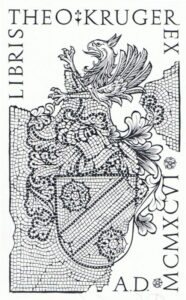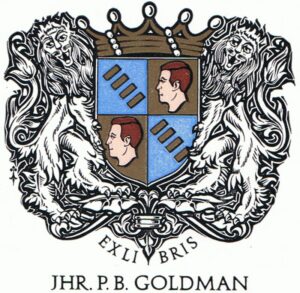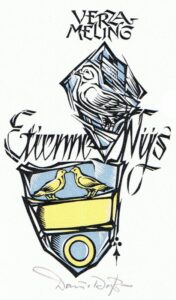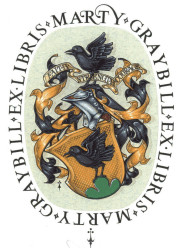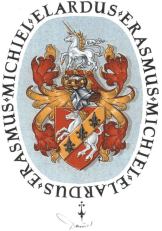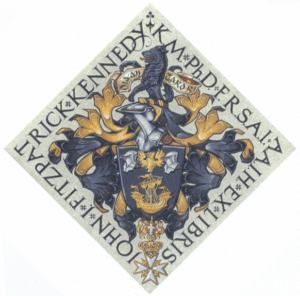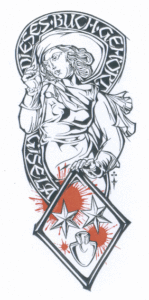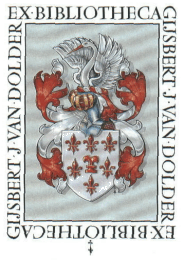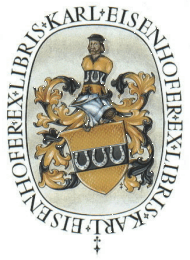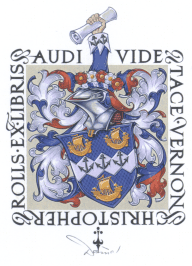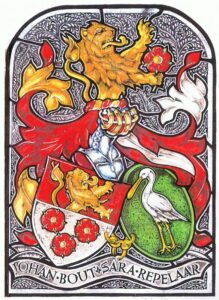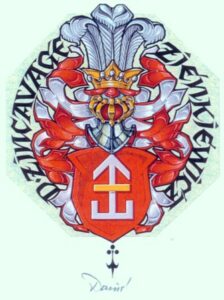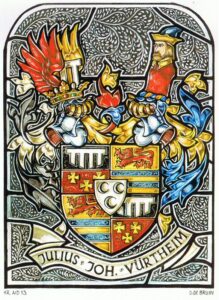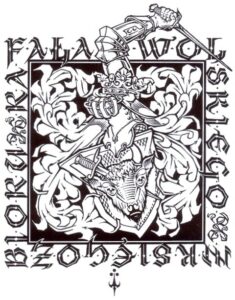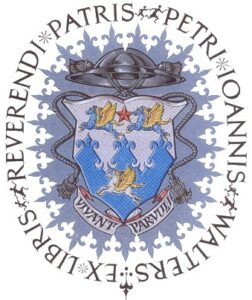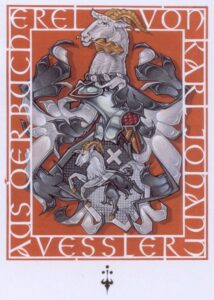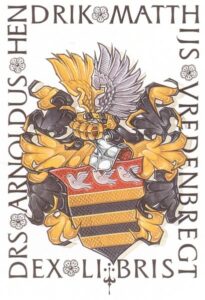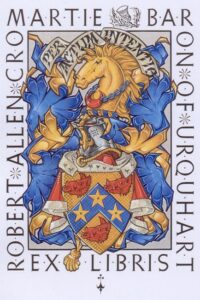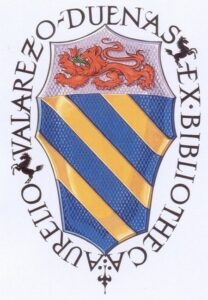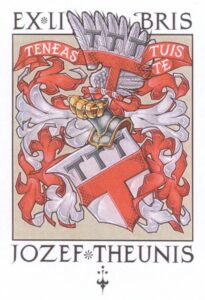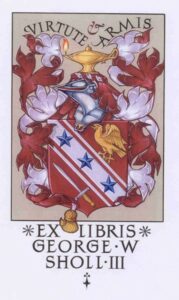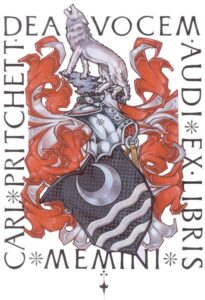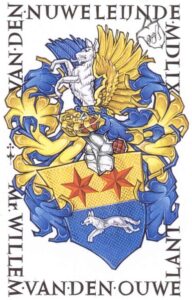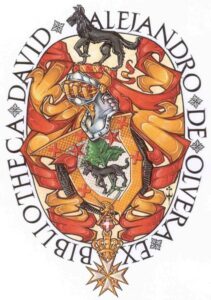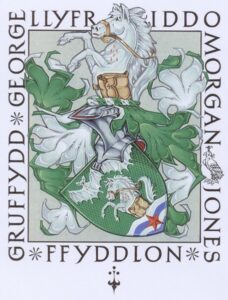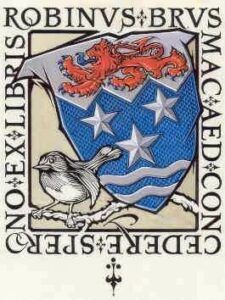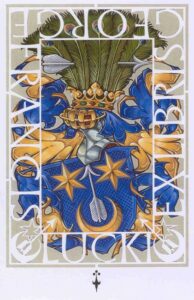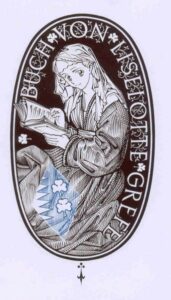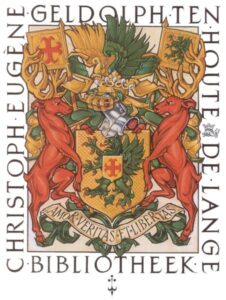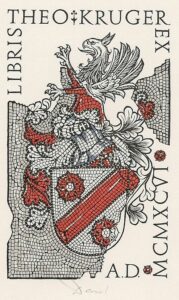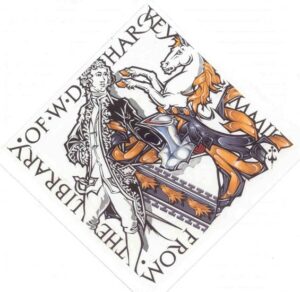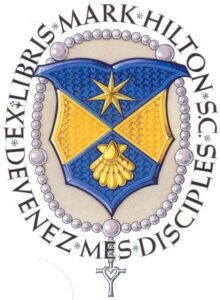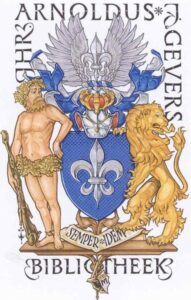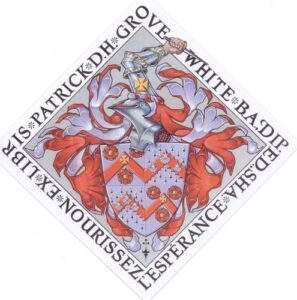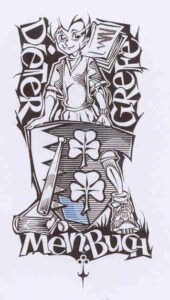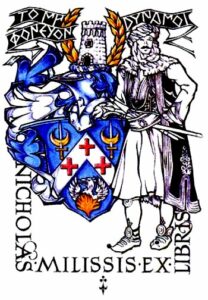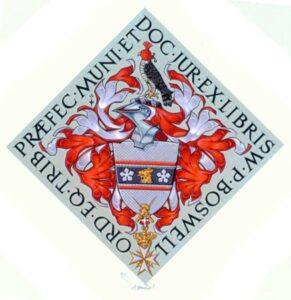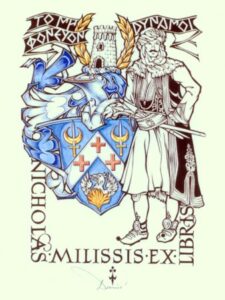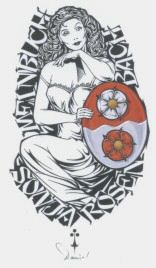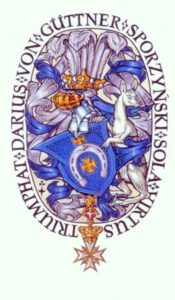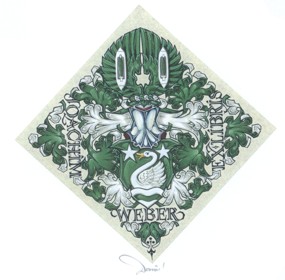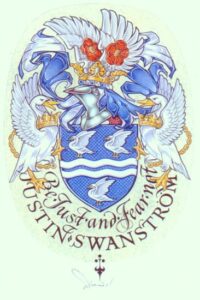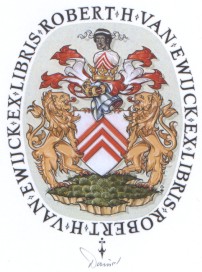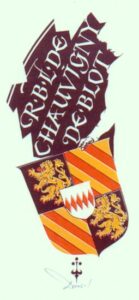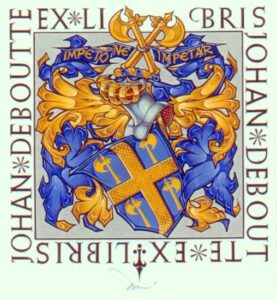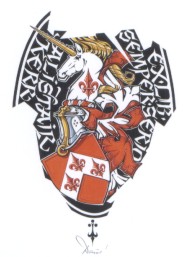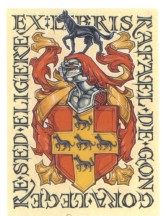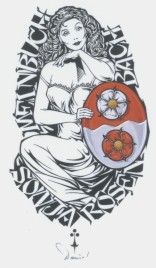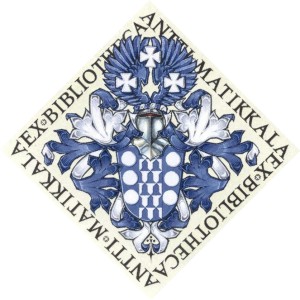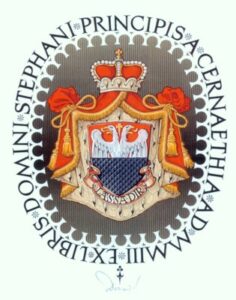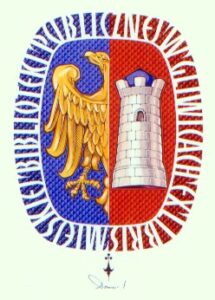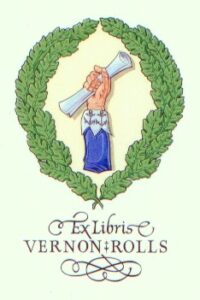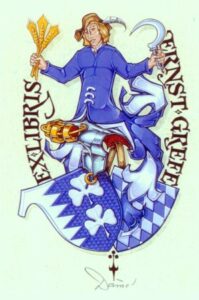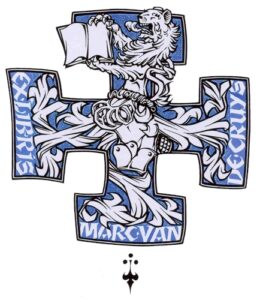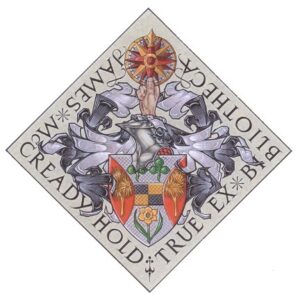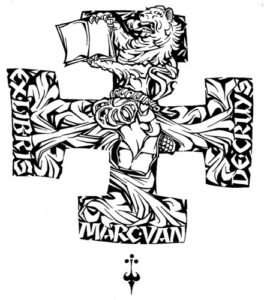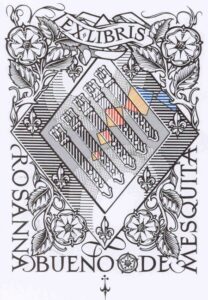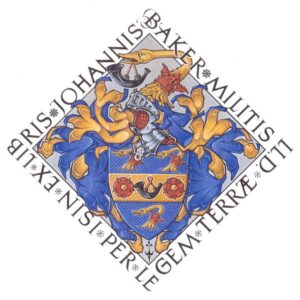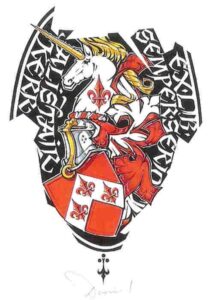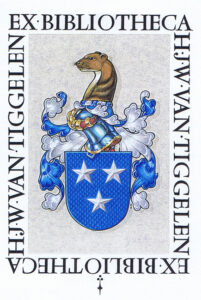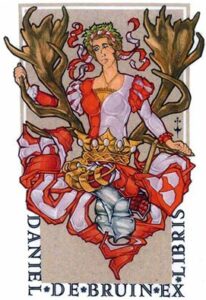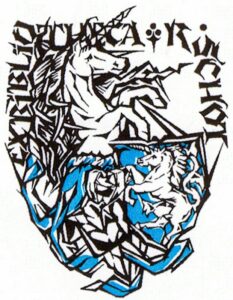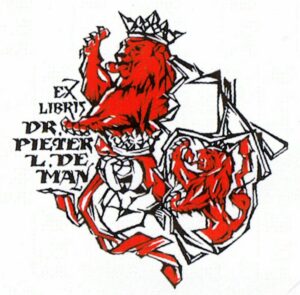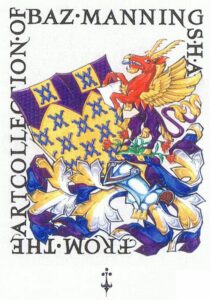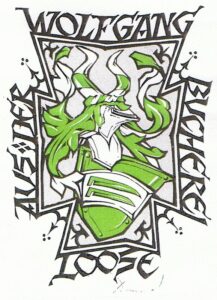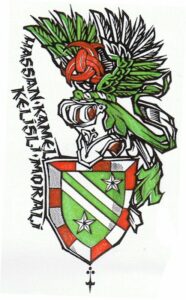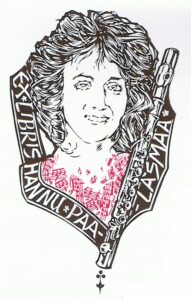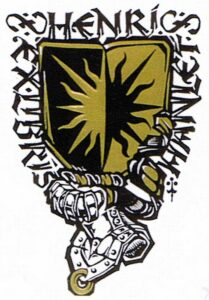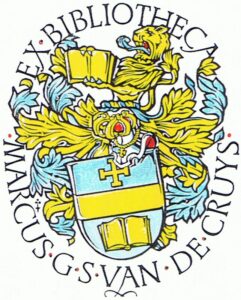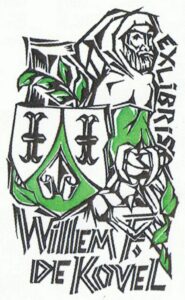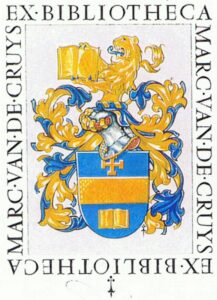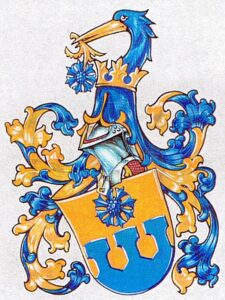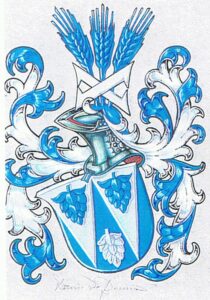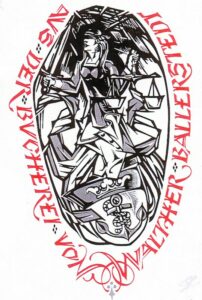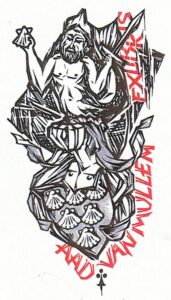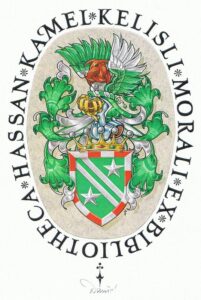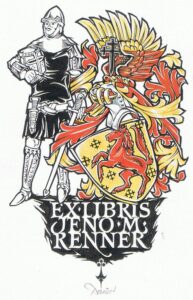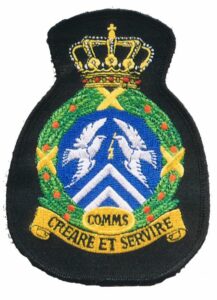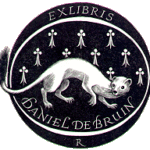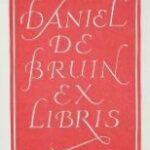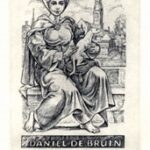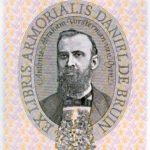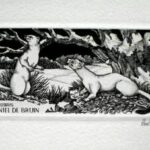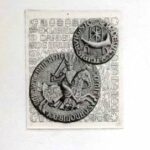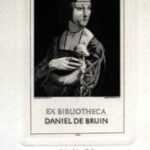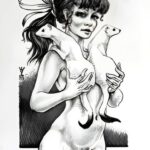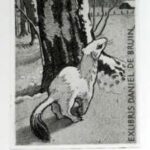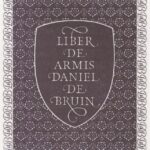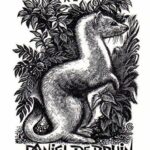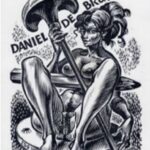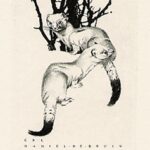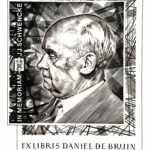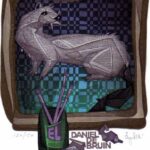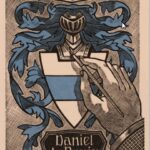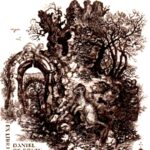I was deeply saddened when I learned of the passing of one of the world’s most brilliant heraldic artists and exlibris designers – and a very dear friend – Daniel de Bruin. I established Daniel’s website years ago out of appreciation for the brilliance of his work, and have maintained it for quite some time. I was fortunate enough to have more than one commission by Daniel, including a unique bookplate design – his specialty. I will continue to leave this site up as a tribute, and am updating a memorial page, which may be seen by clicking the TRIBUTES link. I would invite those of you who either were lucky enough to have received a commission from Daniel, or wish to say anything about him, please email the webmaster. If you wish to have whatever artwork Daniel produced for you included with your comments, be sure to include that as well.
I have lost a dear friend, and heraldry has lost a great artist.
David Robert Wooten
Executive Director, The American College of Heraldry
Daniel de Bruin
Heraldic Artist and Bookplate Collector
DANIEL DE BRUIN was born in Holland on 23 September 1950 at Krimpen aan den IJssel. He passed away, quite suddenly, on 19 October 2010. Although he worked for more than 30 years at the cutting edge of computer technology, his interest lay in the quiet and peaceful world of heraldic arts.
Daniel started collecting heraldic manuscripts, grants of arms and antiquarian books in 1973 and using his extensive collection as a source material, he studied heraldic art and design. By 1976 Daniel had become a passionate collector of heraldic bookplates and commissioned several of Europe’s finest engravers to make bookplates for his own use and through this experience he became acquainted with the art of bookplate design. With his fast growing knowledge of heraldic and graphic arts, Daniel made his first heraldic bookplate in 1981. Discerning bookplate collectors were attracted from the beginning by his modernism and began commissioning plates from him. His vision was to combine traditional heraldry with modern graphics, imaginative concepts and integrated lettering.
His work has appeared in publications in Denmark, Germany, Sweden, Holland, Portugal, and a number of other countries. Several of his bookplates were featured in Von Volborth’s The Art of Heraldry.
From the mid-1980s onward he exhibited work at international exlibris biennials and exhibitions from St Petersburg to Hong Kong and from Tokyo to Beograd. He has also held several personal exhibitions featuring both his own work and bookplates from his extensive historic collection. His expertise in this fine art form led him to be the chairman of the jury of Holland’s first bookplate competition in 1990.
Daniel designed and painted armorials in all the European heraldic traditions. His work was marked with an ermine spot. The selection of this mark reveals the artist’s sentiments using the elegant symbol of purity derived from the myth that the animal would rather to run into fire than dirty its paws in mud.
Some of Daniel’s bookplates can appear to be controversial or may sometimes look avant-garde (his motto was, not surprisingly, DARE TO BE DIFFERENT). However, he did not deny traditional heraldic values and forms. On the contrary, he added to the artistic vision of European heraldic heritage.
He will be sorely missed in an ever-shrinking world of pen-and-ink heraldic artists.
Ex Libris Catalog
Below are all known examples of the artist’s unique and diverse style. All images remain the copyright of the individual owners. It would be greatly appreciated if anyone owning an ex libris not shown below could email a high-resolution image of same to the webmaster for inclusion in this catalog.
Above: Examples of the artist’s progression from initial design idea to finished exlibris
My thanks to Jim McCready and Bernard Juby for their numerous contributions to this gallery
Ex Libris Catalog
Fortunately, Daniel kept a running chronological – but sadly very short – list of all the exlibris he created in his unfortunately short span as an heraldic bookplate artist.
| YEAR | CLIENT | YEAR | CLIENT | |||
| 1981 | 1. | Willem F. de Kovel | 2002 | 60. | Vernon Christopher Rolls | |
| 2. | R. Schot | 61. | W.D. Harvey | |||
| 3. | Dr. Pieter L. de Man | 62. | John J. Fitzpatrick Kennedy | |||
| 4. | Cornelis Fonteljne | 63. | Darius von Güttner Sporzynski | |||
| 1982 | 5. | Albert Luyendijk | 64. | Robin Bruce Mackie | ||
| 6. | Walther Ballerstedt | 65. | Joachim Weber | |||
| 7. | Etienne Nijs | 66. | Nicholas Milissis | |||
| 8. | Aad van Mullem | 67. | Johan Deboutte | |||
| 1983 | 9. | Dom Bernard Daeleman OSB | 68. | R.B.L. de Chauvigny de Blot | ||
| 10. | J. Th. A. Peskens | 2003 | 69. | Justin Swenstrom | ||
| 11. | Dr. Peter Nawroth | 70. | W. P. Boswell | |||
| 1984 | 12. | Ottmar Premstaller | 71. | Familiae Kelisli Morali | ||
| 13. | Fritz Amsmeyer | 72a. | Vernon Rolls | |||
| 1985 | 14. | Margo Verduin | 72b. | Universal bookplate for the Rolls family | ||
| 15. | M.P. de Haas van Riemsdijk | 73. | Public Library Gilwice | |||
| 16. | Wolfgang Loose | 74. | Prince Stefan Cernetic de Cerne | |||
| 1986 | 17. | Kim & Marina Wreesmann | 75. | David Robert Wooten | ||
| 18. | Drs. J. A. de Boo | 76. | Patrick D.H. Grove White | |||
| 19. | Dr. Frank van Soeren | 77. | Marc Van de Cruys | |||
| 1987 | 20. | Carl Alexander von Volborlh | 2004 | 78. | Rosanna Bueno de Mesquita | |
| 21. | G. J. Rhebergen | 79. | Edward Ploysongsang | |||
| 1988 | 22. | Soos of Caulfield | 80. | George W. Sholl, III | ||
| 23. | Jürg Bretscher | 81. | Dieter Grefe | |||
| 1999 | 24. | Alie Vogel de Waal | 82. | I.E. Willetts, MD, FRCS | ||
| 25. | Mr. R.W. van Dijk | 83. | George Francis Lucki | |||
| 26. | Hannu Paalasmaa (non-heraldic) | 84. | Jorge Luis Rivera. III | |||
| 1991 | 27. | Daniel de Bruin | 85. | Liselotte Grefe | ||
| 1995 | 28. | Jhr. P.B. Goldman | 2005 | 86. | David Alejandro de Olvera | |
| 29. | Horst von Diecken | 87. | Gruffiyd George Morgan-Jones | |||
| 1996 | 30. | Theo Kruger | 88. | Aurelio Valarezo | ||
| 31. | Prince Stefan Cernetic de Ceme | 89. | Jozef Theunis | |||
| 1997 | 32. | Marcus G.S. van de Cruys | 90. | Guy Selvesler | ||
| 33. | David Robert Wooten | 91. | Robert Allen Cromartie. Baron of Urquhart | |||
| 34. | Henri Hanlet | 2006 | 92. | Karl Johann Vessler | ||
| 1995 | 35. | Hassan Kamel Kelisli Morali | 93. | Rafal Wolski | ||
| 36. | For the Kelisli family (no text) | 94. | James McCready | |||
| 37. | Emory B. Morris | 95. | Peter Walters | |||
| 1999 | 38. | H.J.W. van Tiggelen | 96. | Christoph Eugene Geldolph Ten Houte de Lange | ||
| 39. | Gijsbert J. van Dolder | 2007 | 97. | Prof Sir John Hamilton Baker | ||
| 40. | David John Tylcoat | 98. | Carl Pritchett | |||
| 41. | Karl Eisenhofer | 99. | Arnoldus Hendrik Matthijs Vredenbregl | |||
| 42. | Hans Kieeberger | 100. | Claude Philippe d’Eslrees | |||
| 43. | Marc van de Cruys | 101. | Marlin Kinkel | |||
| 2000 | 44. | Jeno F Renner | 2008 | 102. | Dr. Med. Frank J. Reuther | |
| 45. | David Robert Wooten | 103. | Robert Neil Pelaez | |||
| 46. | Gisela (Hauck) | 104. | Christoph Eugene Geldolph Ten Houte de Lange (2de versie) | |||
| 47. | Hassan Kamel Kelisli Morali | 105. | Peter Youatt | |||
| 48. | Antti Matikkala | 106. | Brian North Lee | |||
| 49. | Robert H. van Ewijk | |||||
| 2001 | 50. | Marty Graybill | ||||
| 51. | Michiel Elardus Erasmus | |||||
| 52. | D. Zincavage/Zienkiewicz | |||||
| 53. | Richard Anthony Bennett | |||||
| 54. | Rafael de Gongora | |||||
| 55. | Alistair Kerr | |||||
| 56. | Sonja Rosenbach | |||||
| 57. | Ernst Grefe | |||||
| 58. | Oscar Alonso | |||||
| 59. | Baz Manning |
Daniel’s Bookplates

The following exlibris were created by fellow artists for Daniel (above by Lou Strik)
My thanks to Jim McCready and Bernard Juby for their numerous contributions to this gallery
Publications
Herewith follows a listing, although it is in no way complete, of the several publications in which Daniel de Bruin’s work has appeared, as well as the various international ExLibris Exhibitions in which he has participated since 1982.
|
1982 |
Publ: |
Germany: Exlibris Kunst und Graphik, Jahrbuch Deutsche Exlibris Gesellschaft |
|
|
Mag: |
Netherlands: Exlibriswereld, tijdschrift 25ste jaargang |
|
1984 |
Mag: |
Austria: Mitteilungen des Österreichische Exlibris-Gesellschaft |
|
1985 |
Mag: |
Netherlands: Exlibriswereld, tijdschrift 28ste jaargang |
|
|
Publ: |
Danmark: Heraldiske Exlibris Daniel de Bruin, editor Klaus Rödel, Exlibristen |
|
1986 |
Publ: |
Netherlands: Kleine Prentkunst in Nederland in de 20ste Eeuw |
|
|
Mag: |
New Zealand: The New Zealand Armiger, Journal of the Heraldry Society |
|
1987 |
Publ: |
England: The Art of Heraldry, Carl Alexander von Volborth, Blandford Press. |
|
|
Mag: |
Sweden: Exlibriscirkuläret Svenska Exlibrisföreningen ;: en ung okonventionell heraldisk konstnär, complete article |
|
1988 |
Mag: |
Netherlands: Exlibriswereld, tijdschrift 31ste jaargang |
|
|
Publ: |
Portugal: Enciclopédia Bio-Bibliográfica da Arte do Ex-Libris Contemporàneo volume 7. complete article |
|
|
Publ: |
Danmark: Enhjorningen i exlibriskunsten, by Helmer Kofod |
|
1989 |
Publ: |
Japan: A Dictionary of Modern Exlibris |
|
1990 |
Exhib/Cat: |
Germany: das Exlibris von Heute, Catalog 23. Internationen Exlibris-Kongresses der FISAE in Mónchengladbach |
|
|
Mag: |
New Zealand: The New Zealand Armorist, Journal of the Heraldry Society, nr 38, complete article |
|
1991 |
Exhib: |
Spain: Ex-Libris Contemporanis, Barcelona |
|
1992 |
Publ: |
Danmark: Danske dyrlaege-exlibris, by Erik Skovenborg |
|
1995 |
Exhib/Cat: |
Yugoslavia: The World of Exlibris, Catalogue Ex-libris & their artists, Beograde. |
|
1996 |
Exhib/Cat: |
Czechoslowakia: Catalog 26th International Congress of the FISAE in Chrudim |
|
1998 |
Exhib/Cat: |
Russia: World Exof the libris 1996-1998, Catalog 27th International Congress of the FISAE in St. Petersburg |
|
|
Mag: |
Belgium: Heraldicum Disputationes, Kwartaalblad voor Heraldiek, jaargang 3, nr.3 |
|
|
Mag: |
England: The Heraldic Craftman, year 1998, issue 29 |
|
1999 |
Mag: |
New Zealand: The New Zealand Armorist, Journal of the Heraldry Society, nr 72. |
|
|
Mag: |
Belgium: Heraldicum Disputationes, Kwartaalblad voor Heraldiek jaargang 4, nr 3 |
|
2000 |
Exhib/Cat: |
Poland: XVIII Miedzynarodowe Biennale Ekslibrisu Wspolczesnego Marlborg, final selection |
|
|
Exhib/Cat: |
Spain: Ex libris in the 21st Century, organized by the University of Barcelona. |
|
|
Mag: |
Belgium: Heraldicum Disputationes, Kwartaalblad voor Heraldiek jaargang 5, nr 3 |
|
|
Mag: |
England: The Heraldic Craftman, year 2000, issue 37 |
|
|
Exhib: |
Netherlands: The Johan Schwencke Award 2000, The Hague |
|
2001 |
Exhib/Cat: |
Hong Kong: International Ex Libris Exhibition in commemoration of the grand opening of the Hong Kong Central Library |
|
|
Exhib/Cat: |
Lithuania: XII Tarptautine Vilniaus Ekslibrisu Bienale, Vilnius |
|
|
Exhib: |
Mexico: International Ex Libris Exhibition, “Homenaje a las Aves“ Guadalupe |
|
2002 |
Exhib/Cat: |
Poland: IV Miedzynarodowy Konkurs Graficzny na Ekslibris in Gliwice, Upper Silesia |
|
|
Publ: |
England: The Complete book of Heraldry by Stephen Slater, editor, Lorenz Books |
|
2003 |
Exhib/Cat: |
Czech Republic: III. Trienale, Havirov 2002 |
|
|
Exhib/Cat: |
Belgium: Biennale van de kleingrafiek, Thema: Mythologie in Sint Niklaas, final selection |
|
|
Exhib/Cat: |
Austria: Exlibris – Sammlung des Stadtmuseums Bruneck, Tirol |
|
|
Exhib/Cat: |
Romania: International Bookplate exhibition, National Museum Of Art, Cluj-Napoca |
|
|
Exhib/Cat: |
Turkey: The 1st International Ex-libris Competion Exhibition in Ankara, final selection. |
Tributes
 Several years ago I was happy to find the website of Daniel de Bruin, a heraldic artist who specialized in heraldic bookplates. I commissioned him to do a bookplate for me. I recall that he was always in demand because of the quality of his work and it was very difficult to get on the list, so to speak, of commissions he was willing and able to undertake. But, I was fortunate. He had, at that time anyway, never done a bookplate for a clergyman before and was eager to try his hand at it. Luckily I wanted something rather simple and Daniel was kind enough to get to work as soon as he was able.
Several years ago I was happy to find the website of Daniel de Bruin, a heraldic artist who specialized in heraldic bookplates. I commissioned him to do a bookplate for me. I recall that he was always in demand because of the quality of his work and it was very difficult to get on the list, so to speak, of commissions he was willing and able to undertake. But, I was fortunate. He had, at that time anyway, never done a bookplate for a clergyman before and was eager to try his hand at it. Luckily I wanted something rather simple and Daniel was kind enough to get to work as soon as he was able.
I didn’t give him too much direction because he was a man of extraordinary creativity and I wanted to see what he would come up with. He depicted my arms surrounded by the legend I had requested but also offset the arms from the simple white background by means of an oval shape the outer edge of which mimicked the line sapiné contained on the chief of my coat of arms. It was brilliant! Apparently, it was also labor intensive because when I expressed my pleasure upon seeing it Daniel exclaimed his relief that I wasn’t going to ask him to go back to the drawing board! He also had the very pleasant habit of “signing” his work not by placing his name or monogram on it (and potentially spoiling it) but by incorporating a single ermine spot, a sort of personal symbol of him, into each piece. I treasure the bookplate all the more now that I have received the news of his tragic and untimely death. The heraldic world, which seems to have been losing so many fine members in recent years, has lost another giant.
His work was exceptional and unique. Daniel was a pleasant person to deal with who showed a great deal of respect for his clients as well as tremendous expertise in the field. There will be a great hole left in the world of heraldic art and of the art of the bookplate with his passing. Those of us who were fortunate enough to have worked with him realize that it was a great privilege.
May he rest in peace.
(Fr.) Guy W. Selvester

 I originally ran across an example of Daniel de Bruin’s unique artwork in von Volborth’s The Art of Heraldry. Quite obviously it leapt off the page at me, as it was radically different than most of the “traditional” heraldic achievements being produced to date (most of which were simply mimicking 17th and 18th century engravings). I initially wrote to Daniel inquiring about developing a unique personal bookplate, having exhausted my own limited artistic talent in the same pursuit (http://drw.9august.com).
I originally ran across an example of Daniel de Bruin’s unique artwork in von Volborth’s The Art of Heraldry. Quite obviously it leapt off the page at me, as it was radically different than most of the “traditional” heraldic achievements being produced to date (most of which were simply mimicking 17th and 18th century engravings). I initially wrote to Daniel inquiring about developing a unique personal bookplate, having exhausted my own limited artistic talent in the same pursuit (http://drw.9august.com).
 Some years later, while working with the late Dr. David Pittman Johnson, former President of The American College of Heraldry and a brilliant heraldist in his own right, we attempted to develop an endowment fund for that organization. In order to differentiate the fund from “normal” College activities, I recommended that we have a new rendering of the College’s armorial achievement produced, and turned to Daniel for the commission. The result still was fairly “normal” in terms of layout, but reflected his unique style.
Some years later, while working with the late Dr. David Pittman Johnson, former President of The American College of Heraldry and a brilliant heraldist in his own right, we attempted to develop an endowment fund for that organization. In order to differentiate the fund from “normal” College activities, I recommended that we have a new rendering of the College’s armorial achievement produced, and turned to Daniel for the commission. The result still was fairly “normal” in terms of layout, but reflected his unique style.
 A short time later, after finally convincing Daniel to let me develop a website to display his incredible talent to the world, I decided to commission him to produce a full-color bookplate for me.
A short time later, after finally convincing Daniel to let me develop a website to display his incredible talent to the world, I decided to commission him to produce a full-color bookplate for me.
Having seen other examples of such exlibris from his portfolio, I knew I wanted a somewhat eclectic layout – while I am not entitled to supporters in my own armorial achievement, I noted Daniel had taken some slight “liberties” with other armigers’ bookplates, including a full-length version of whatever their crest might be alongside the shield, helm, crest, etc. As my personal crest was a satyr’s head (couped, with bat’s wings for ears and an olive wreath about it), Daniel rendered a full-size “supporting” satyr aside the achievement. For some reason, not the first time he had done so, he “flopped” the achievement, turning shield, helm, and crest to sinister. Perhaps, in his mind, this made the design less “authentic heraldry,” and thus he was able to include the “supporting” figure. I never did get an explanation, but could really not have cared less – the design was incredible, and those who have commissioned Daniel for exlibris know that the small packet of color-printed bookplates are more like individual mini-masterpieces. With very few exceptions, I have been hesitant to even tip in many of the plates, as I want to save them for some reason. One pack remains in mint/pristine, unopened condition. As far as I’m concerned, they are priceless.
 A separate bit of artwork I commissioned of Daniel was a recreation of the 25th Fusiliers badge for The International Overseas Command of the Legion of Frontiersmen. As with all of his work, he took a rather “staid” original design, and though maintaining the integrity of the layout, produced a much more appealing end result.
A separate bit of artwork I commissioned of Daniel was a recreation of the 25th Fusiliers badge for The International Overseas Command of the Legion of Frontiersmen. As with all of his work, he took a rather “staid” original design, and though maintaining the integrity of the layout, produced a much more appealing end result.
As to Daniel the man, we never met in person. We spoke on the phone only once. But our e-mail correspondence was extensive, and the one word I can think of to sum up his character is humble. While he was consistently backlogged with commissions, and was aware of his popularity, he was loath to brag about his work.
 For years I had anguished over how to incorporate my own initials into an attractive cipher/monogram. Granted, some individuals have letters that more aesthetically incorporate when combined. Mine, it appeared, did not.
For years I had anguished over how to incorporate my own initials into an attractive cipher/monogram. Granted, some individuals have letters that more aesthetically incorporate when combined. Mine, it appeared, did not.
I then asked Daniel to put his brilliant artistic mind to it, and in very short order he came up with a simple, but beautiful, cipher.
 Click thumbnail at right for enlarged image showing Daniel’s original design suggestions for this cipher – each a unique piece of art in themselves.
Click thumbnail at right for enlarged image showing Daniel’s original design suggestions for this cipher – each a unique piece of art in themselves.
Whenever we updated this website with his latest commissions (one perk of working with Daniel was that I received printed color samples of his latest commissions, so I have a nice little de Bruin exlibris collection), he would inevitably tell me to remove as many samples as I posted new ones – however, with his passing, I felt compelled to re-post all available plates for his fans enjoyment. He didn’t want to “bore” people with too much of his work. At the same time, each successive rendering reflected an ever-evolving style, and he didn’t want potential clients to think they might be getting a final drawing that didn’t reflect his then-current favored style.
There are far too few brilliant heraldists living today. I am acquainted with several, and have commissioned even more to render my own arms (see my personal website as linked above) – a practice I encourage all armigers to pursue. But whenever someone asked me, in my current position as Executive Director of The American College of Heraldry, for my personal opinion on who they should get to render their armorial bearings into a bookplate, Daniel’s name came out of my mouth by sheer reflex.
Daniel was my friend, and I will miss him deeply.
David Robert Wooten
Executive Director
The American College of Heraldry
I first became aware of Daniel’s work in 1985 when Blandford Press published CA von Volborth’s The Art of Heraldry. I had Graduated from my heraldic art course in 1983 and thought I knew all there was to know about heraldic art work. Then I saw Daniel’s work!
Instantly I was taken with his strong sense of design, his graphic style that so reminded me of powerful woodcuts and I was hooked. I wrote to him that year and we corresponded on several occasions and he sent me many samples of his work and other book plates too.
I found him to be the most kind and generous man and also quite humble about his designs. He was a true heraldic artist with an original talent who loved his subject with a passion.
The heraldry world will mourn the loss of this superb craftsman but his name will live long through his exquisite designs.
I send my condolences to his family and friends. Thank you Daniel for that early inspiration and may you Rest in Peace my friend.
Andrew Stewart Jamieson
I was deeply saddened to hear that Daniel, a brilliant artist and a generous and kind man, had passed away. As a student of heraldic art, Daniel’s heraldic bookplates have always been a source of inspiration and admiration to me. The boldness of the lines and the creativity of the design made Daniel’s bookplates stand out. His unique style will be missed, and it is sad to know that the little ermine spot will no longer appear on new bookplates.
Some years ago I asked Daniel to create a bookplate for me, but at the time he didn’t take any new commissions in, due to the high demand of his artwork. He very kindly sent me some of his bookplates, which are now amongst the treasures of my collection, and we stayed in touch, discussing heraldic art from time to time.
Daniel dared to be different, and it showed in his art and in the legacy he has left behind. The world of heraldic art has lost a Master.
Ronny Andersen
This morning, Daniel was laid to rest. He was always so proud of his work and deservedly so. Apart from his much appreciated work, he was also a very much loved and liked man. I hope this site will continue to celebrate his work and person and the legacy he leaves behind. He will be missed.
Elke van Geelen
Just a few minutes ago I heard of Daniel’s death. I was shocked and still am. Just a few weeks ago I corresponded with him about a few ideas we at CBG had. And now this… Although I have known about him for over thirty years, I only met him in the flesh last year. We immediately felt a rapport as it turned out we had admired each other’s work from afar for years. He actively supported me and colleague Guus van Breugel in our efforts to modernise the CBG Wapenregister. His support strengthened us no end. I also recognised him as a genial and warm-hearted person and a wonderful draughtsman. I have known him for far too short a time, but I will still miss him immensely.
Henk ‘t Jong
It’s a great loss and I am sad. Daniel was so kind a guy, and a so brilliant artist. We had exchanged very friendly messages and bookplates, and he said many kind words about my works (it’s an honour for me). He pushed me to make bookplates in colour. I was amazed by his artistic sense of drawing and colours. His renditions were always very dynamic and surprising. He was a complete artist. It is always the same stupid regrets, because I intended to go to visit him this year…
RIP Daniel in the artists’ paradise! Alas, you sadly verify the motto of our community: “vita brevis, ars longa.”
Laurent Granier
Only now I have the very sad and unexpected news of the Daniel de Bruin’s death. I offer to his family and friends my condolences. I will always admire and remember Daniel’s innovative talent and absolute excellence in the heraldic art, and his personal kindness too. Like other great heraldic artists, I am sure his work will remain with us: a joy for heraldists and an admirable Lectio Magistralis for colleagues. Riposi in pace.
Marco Foppoli
I am bereft! It has taken me several days to be sufficiently composed to write this. The worst of a sudden death at any age is the shock it gives you. We had no time to prepare ourselves for his passing. It has made me all the more determined to meet as many fellow artists as I can when the opportunities arrive. I am also painfully aware once more of our limited time here. Daniel’s death has made me want to apply myself more vigorously to my own work.
Daniel and I were in touch for two decades, firstly by letter and then by email. Even though we never met face to face we shared such a meaningful correspondence that his unexpected loss has affected me deeply. There have been some sad losses amongst the world’s tiny heraldic art community in recent years, all leaving us too soon, but Daniel’s loss will be felt all the more keenly as his work was truly special, in a style unlike any other.
There are many ways to describe a great artist but his art was uniquely great. There was never anyone like him before and no one is working in a similar style now and possibly never will. He was a superb artist, combining this skill with strong, competent draughtsmanship and a clever use of advanced computing skills to produce his individual masterpieces. He was the first and best of us to combine hand drawn art and computing skills and did this so seamlessly and with such consummate ease that many never realised how involved he was with the computer. He claimed to me that in spite of his proficiency with the computer he did not use a PC to do his bookplates, but close study of them sometimes showed traces of this to me and other artists. He promised to show me exactly how it was done when his critics were no longer around to belittle his efforts, but he has gone before them and taken the secrets with him. History may judge him to have been irreplaceable.
God bless you Daniel.
Baz Manning
As a contributor at the Amsterdam Antiquarian Bookfair I missed the usual visit of Daniël, only to learn some weeks later, he had suddenly and very unexpectedly passed away…. In his early days as a collector we had lengthy evenings with discussing what to buy [and more what not to…] and for many years we were attending auctions and fairs. His sharp judgment resulted in an fine, carefully “handpicked” library, only the very best copies were good enough to buy. He was always capable of sharing his knowledge and enthusiasm with others , while always being his reserved, modest self… He will not only be missed by his family…
Ernie Quist
 When I read of Daniel’s death I felt as if a mighty tree had fallen in the forest leaving a gap which will not be filled in my lifetime. My sadness reminded me of his 2001 bookplate for Alistair Ross, one of my favourites (but strangely not accepted by his client). The time-ravaged seal is very evocative of past glories laid low. It was 20 years ago when I first saw his early plates and was excited by his inventiveness in design: clearly a young artist determined to bring fresh, modern ideas to heraldic art. As his style matured he continued to delight me with his creativity and excellence in technique and printing quality. Now over 100 plates later I feel honoured to have all but the most recent in my collection. This will soon be safely lodged in the University of Otago’s Hocken Library – a fitting memorial in remote New Zealand Daniel was a wonderful correspondent, generous with his duplicates and his superb personal plates engraved and etched by Europe’s best.
When I read of Daniel’s death I felt as if a mighty tree had fallen in the forest leaving a gap which will not be filled in my lifetime. My sadness reminded me of his 2001 bookplate for Alistair Ross, one of my favourites (but strangely not accepted by his client). The time-ravaged seal is very evocative of past glories laid low. It was 20 years ago when I first saw his early plates and was excited by his inventiveness in design: clearly a young artist determined to bring fresh, modern ideas to heraldic art. As his style matured he continued to delight me with his creativity and excellence in technique and printing quality. Now over 100 plates later I feel honoured to have all but the most recent in my collection. This will soon be safely lodged in the University of Otago’s Hocken Library – a fitting memorial in remote New Zealand Daniel was a wonderful correspondent, generous with his duplicates and his superb personal plates engraved and etched by Europe’s best.
A great collector, he shared his enthusiasm, and quickly became one of the truly great heraldic artists.
Jim McCready
 I have just heard with great sorrow of the death of Daniel de Bruin. Although we never met, he responded with great warmth and enthusiasm to the challenge of designing a bookplate for me which would be based on my arms but which would include an allusion to my work with street-children in Colombia.
I have just heard with great sorrow of the death of Daniel de Bruin. Although we never met, he responded with great warmth and enthusiasm to the challenge of designing a bookplate for me which would be based on my arms but which would include an allusion to my work with street-children in Colombia.
He told me that he knew immediately how he wanted to do it, so I left him to get on with it without asking for any details. The finished design shows that he had seen how to incorporate the running figures of two street-children – which figure in the logo of the charity for which I work – into the lettering around my arms. I count myself very privileged to have this fine example of his work.
As well as being a superb and highly creative heraldic artist, Mr de Bruin was also very generous with his time and talent. He refused to accept any payment for this commission, and was happy to support our work by means of the small donation I made to the charity as a token of my appreciation of his kindness.
May he now rejoice with the herald angels and rest in peace.
(Fr.) Peter Walters
In October 2006 I got to know Daniel, not personally, but by e-mail. I was wondering if this master of bookplates would create one for me as well. We had friendly and warm conversation. Finally in January 2010 I got the bookplate. I was astonished and overwhelmed by the craftsmanship and especially the innovativeness. Afterwards we kept in contact. We discussed about two publications of Daniel which I made available online. It was a great honour for me, that Daniel put a picture of him with my bookplate on top of his homepage. I feel so sorry to hear from his sudden and early death.
Dr. Frank J. Reuther, Ulm
Daniël de Bruin
(29th September 1950 – 19th October 2010)
The message that Daniël de Bruin passed away completely unexpected on October 19th, was a great shock for many heraldists and lovers of ex libris and small graphic art. Several of them had seen him and talked to him only very recently on heraldic events. Also the recent issue of the magazine Heraldicum Disputationes (2010 – nr. 3) from Flemish Belgium published one of his articles.
At the age of 20, he discovered his graphic skills. He focused on calligraphy and the art of designing type. His interest in heraldry – in particular the design of it – caused him to start collecting and subsequently designing coats of arms and ex libris. His style was inspired by (among others) the Swiss artist Paul Boesch, famous for his woodcuts. The strong and angular lines of the woodcut can be recognised in the designs by De Bruin until the early 1990s. In his first bookplate for Willem de Kovel (1981) he deviated from the usual heraldic styling by placing the helmet and helmet sign at the base next to the escutcheon. Also in his later works he sought the boundaries of heraldic design – his motto was ‘dare to be different‘ – and this was not always appreciated by his clients. In 2007 his salon des refusés contained about 20 refused designs. They give us a good impression of the boundaries he explored while trying to renew the genre.
In the nineties his style became more refined, more classical if you like, but remained very clear and recognizable as his own style, without ever repeating itself or becoming a stereotype. Every bookplate is unique, without compromises. He signed his designs with an ermine spot. Of the ermine it is said that it, on the run from approaching danger, on a fork in the road it selected the fire, rather than making its paws dirty in the mud.
‘Thanks to the ascent of the internet I was able, from 1996 onwards, to build a heraldic website with my ex libris,’ he wrote. ‘The website with its sparkling computer screen creates an effect that is almost like stained glass and emphasizes the strong points of heraldry.’ (1)
The applied heraldic art of the ex libris was not the only field De Bruin was working in. The new municipal coats of arms of the towns of Vlist and Ouderkerk are his work as well. (2)
Daniël de Bruin was a heraldic artist of international standing. He was for instance a member of the very prestigious Society of Heraldic Arts of Reigate, and on the 14th International Biennale in Vilnius (Lithuania) of 2005 he received the Ex Libris award.
The death of this amiable en modest person is a great loss for the heraldic artistry.
(1) Over het tekenen van heraldische boekmerken (in the series ‘Over het tekenen van wapens [about designing coats of arms]’ nr. 3, Homunculus uitgaven Wijnegem 2007).
(2) cf Ned. Leeuw nr. 103 (1986), pages 188-190




In Memorium
DANIEL DE BRUIN
Heraldic bookplate artist
Born September 23, 1950 – Died October 19, 2010
Daniel de Bruin, who has died suddenly aged 60, was one of Europe’s leading heraldic bookplate designers, and whose treatment of the art broke the unwritten rules then existing.
His acclaimed work graces collections across Europe from Poland to Portugal including the Vatican, and distinguished clients sought him out from every continent. Bibliophiles marked ownership of their volumes with work by de Bruin that assumed form in rectangle, square, roundel, diamond and cartouche.
It is the mark of the man that de Bruin’s work appears in the archives of Sir Ilay Campbell of Succoth, Scotland’s leading bookplate collector, as well as that of an Edinburgh bus driver.
Daniel de Bruin was born and lived all his life in the small Dutch town of Krimpen aan den Ijssel. Fascinated from childhood by colourful images reinforced by a boyhood collection of football badges, his latent ability in graphics led him into a self-taught path of calligraphy and letter design by the time he was 23, a move that introduced him to the world of heraldry, and he became fascinated by how bookplates established both decoration and provenance in books.
Inspired by modernist engravers such as Professor Mark Sverin, Pieter Wetselaar and Win Zwiers, de Bruin became influenced by the relationship of solid line and black-against-white – and the functional way in which his fellow Dutch typographer and engraver Pieter Wetselaar gave form to bookplate design.
While he enjoyed the tradition of the English masters like Edward Kruger Gray and John Vinycomb, Daniel was particularly inspired by those he termed the “masters” – the Scottish heraldic draughtsmen Graham Johnston, AG Law Samson and John Sutherland.
His first commission came in 1981, but it was his day job in computing that gave him a lead through the internet revolution of the mid-1990s. He set out to establish himself electronically, as well as using the net to examine heraldic sources otherwise unknown to him. By 1996, he had become one of the earliest users of a website, and this – coupled to availability of cheap technology in colour printing and appointment as a craft member to the Society of Heraldic Arts – established him globally.
He fashioned unusual and delicate work for Father Peter Walters in Colombia and Robert Urquhart, baron of Cromartie, stretching boundaries in conventional design by using integrated lettering within an anciently expressive culture.
His work attracted critical acclaim, appearing in leading publications of a dozen nations. Several of his bookplates feature in Alexander von Volborth’s opus The Art of Heraldry, and from the mid-1980s, his bookplates appeared in international exhibitions from St Petersburg to Hong Kong, Tokyo to Belgrade. His expertise led him to be appointed chairman of the first bookplate competition in the Netherlands in 1990.
De Bruin’s motto was, not surprisingly, Dare To Be Different, and he marked his work with an ermine spot – a choice of personal insignia deriving from the myth that a white stoat (the “ermine”) would rather run into fire than dirty its paws in mud.
He never allowed either his trademark scholarliness nor his personal style to erase the style of heraldry practised in a particular region. Thus the bookplate of Johan Deboutte in Belgium is infused with Flemish spirit, while that for the Mexican David de Olverara-Ayes shows Spanish heraldry of his Conquistadorean ancestor of 1519 Diego de Olvera. For his clients, he employed heraldic influences running from the Turkish and Egyptian to the Japanese and Welsh, and even produced a recognisable heraldic signature to recent work for Carl Pritchett in Texas.
The noted Danish heraldic bookplate designer Ronny Andersen went as far as turning the tables on his own trade in asking de Bruin to design for him.
A modest man, de Bruin brought pictorial language in new form to today’s visually-focused society, and without four decades, has produced a body of work almost unparalleled in its exuberance and celebration of heraldry.
– Obituary by Gordon Casely
In memoriam Daniël de Bruin
(29th September 1950 – 19th October 2010)
The message that Daniël de Bruin passed away completely unexpected on October 19th, was a great shock for many heraldists and lovers of ex libris and small graphic art. Several of them had seen him and talked to him only very recently on heraldic events. Also the recent issue of the magazine Heraldicum Disputationes (2010 – nr. 3) from Flemish Belgium published one of his articles.
At the age of 20, he discovered his graphic skills. He focused on calligraphy and the art of designing type. His interest in heraldry – in particular the design of it – caused him to start collecting and subsequently designing coats of arms and ex libris. His style was inspired by (among others) the Swiss artist Paul Boesch, famous for his woodcuts. The strong and angular lines of the woodcut can be recognised in the designs by De Bruin until the early 1990s. In his first bookplate for Willem de Kovel (1981) he deviated from the usual heraldic styling by placing the helmet and helmet sign at the base next to the escutcheon. Also in his later works he sought the boundaries of heraldic design – his motto was ‘dare to be different‘ – and this was not always appreciated by his clients. In 2007 his salon des refusés contained about 20 refused designs. They give us a good impression of the boundaries he explored while trying to renew the genre.
In the nineties his style became more refined, more classical if you like, but remained very clear and recognizable as his own style, without ever repeating itself or becoming a stereotype. Every bookplate is unique, without compromises. He signed his designs with an ermine spot. Of the ermine it is said that it, on the run from approaching danger, on a fork in the road it selected the fire, rather than making its paws dirty in the mud.
‘Thanks to the ascent of the internet I was able, from 1996 onwards, to build a heraldic website with my ex libris,’ he wrote. ‘The website with its sparkling computer screen creates an effect that is almost like stained glass and emphasizes the strong points of heraldry.’ (1)
The applied heraldic art of the ex libris was not the only field De Bruin was working in. The new municipal coats of arms of the towns of Vlist and Ouderkerk are his work as well. (2)
Daniël de Bruin was a heraldic artist of international standing. He was for instance a member of the very prestigious Society of Heraldic Arts of Reigate, and on the 14th International Biennale in Vilnius (Lithuania) of 2005 he received the Ex Libris award.
The death of this amiable en modest person is a great loss for the heraldic artistry.
(1) Over het tekenen van heraldische boekmerken (in the series ‘Over het tekenen van wapens [about designing coats of arms]’ nr. 3, Homunculus uitgaven Wijnegem 2007).
(2) cf Ned. Leeuw nr. 103 (1986), pages 188-190
All images copyright their original owners. Website copyright David Robert Wooten, 1990-2025, all rights reserved.
